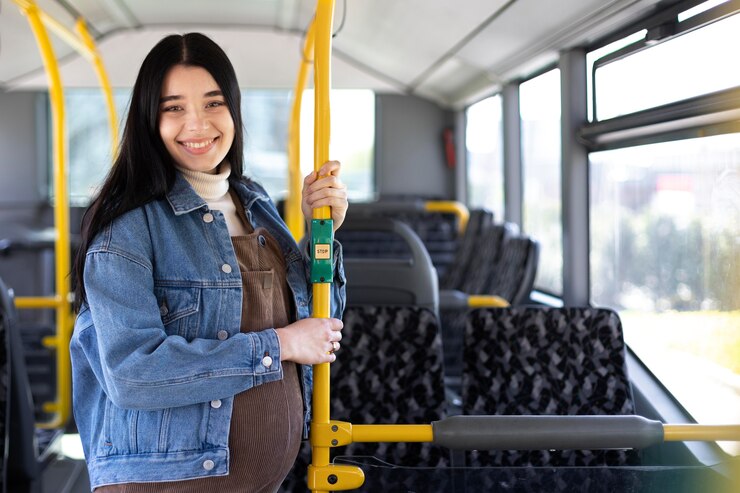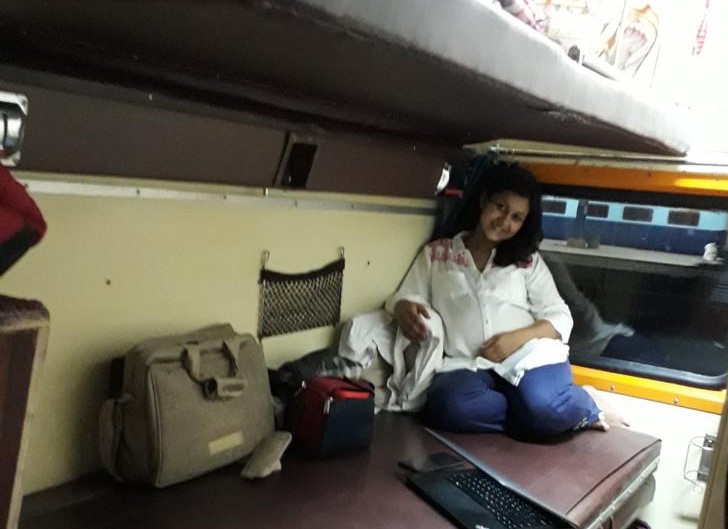Travelling while pregnant is just as enjoyable as ever as long as necessary precautions are taken in advance. Ideally, it is advisable to get a physical examination done prior to long duration journeys as it’s always safe to rule out any unprecedented circumstances while travelling. By communicating about the travel plans with the doctor, it’s possible to receive customized guidelines about do’s and don’ts in accordance with your pregnancy and personalized health track records. In general, planning a few important things ahead about comfort and safety ensures a stress free travel experience. Foreseeing any adverse situations or emergencies that may come up and the possible alternatives to handle such situations need to be discussed before any travel.
In this article –
- Best time to travel during pregnancy.
- Circumstances under which travelling need to be Limited / Avoided.
- Warning Signs that need immediate attention while travelling.
- Travel by Road.
- Travel by Train.
- Travel by Air.
- Food safety and personal Hygiene while travelling
- Must have Essentials while travelling
Best time to Travel during Pregnancy
- As mentioned earlier, healthy pregnant women can safely travel close to due date under normal circumstances. But, the second trimester from 14 to 28 weeks is considered the best period to travel, as the risk of complications is the lowest.
- Morning sickness, fatigue, mood swings, anxiety and risk of miscarriage make it hard for most of women to travel in the initial weeks of pregnancy.
- The weeks closer to labor are tiring, uncomfortable to move around freely and there is always risk of early labor, so it is always advisable to limit travel and stay close to home.
Circumstances Under Which Travelling Need To Be Limited / Avoided
- Even though travelling is safe during pregnancy, there are certain situations and health conditions that refrain pregnant women from travelling in general or at least limiting it to some extent.
- Heart diseases in pregnant women,
- Gestational diabetes,
- Respiratory illness,
- Sickle cell disease,
- Recent hemorrhage,
- Severe anemia is some of the health conditions that need restrictions in travel. In inevitable cases, the travel should be strictly monitored and guided by the doctor.
Complications in present pregnancy like –
- Preeclampsia,
- Ectopic pregnancy,
- Multiple fetuses,
- Incompetent cervix,
- Placental abnormalities can always carry a risk of spontaneous abortion or premature labor.
- High blood pressure in pregnant mother,
- Earlier incidents of miscarriage,
- Vaginal bleeding,
- Infertility issues,
- Risk of early labor are some other circumstances where travelling is restricted. Depending on the severity of these conditions, the medical health care professional decides the safest options.
Warning Signs that need immediate attention while Travelling

It is very important to be aware of and interpret some signals that needs immediate call for help
- Vaginal bleeding/passing tissue or clots
- Rupture of membranes or “water breaking “
- Pelvis or abdominal pain or contractions (please note, some pains and contractions might not be a cause of worry, check for different types of contractions and when to raise an alarm)
- High fever/ breathing difficulty
- Symptoms of preeclampsia ( headaches/seeing spots/ changes in eyesight/ swelling of hands and face )
- Signs of DVT –Swelling of legs (Deep vein thrombosis- condition in which blood clot forms in veins, usually in legs or around pelvic areas)
- Signs of severe dehydration
- Heavy morning sickness with persistent vomiting
Travel by Road

Travelling by car can be made more comfortable by practicing certain simple safety procedures.
- Wear seat belt always. The cross strap positioned between the breasts and lap strap across the pelvic area under the bump.
- While driving, move the seat as back as possible to stretch legs comfortably. Adjust the steering wheel to keep it as away from the stomach as possible. If needed, provide support cushion for resting the back or neck during the journey.
- Avoid rapid acceleration, hand breaking, and avoid poor road conditions as much as possible to minimize jolting and improper movement.
- Sitting for long hours in a car or train can be uncomfortable for legs and back; can also increase the risk of blood clot in legs, a condition called –DVT, deep vein thrombosis. If left unnoticed this can lead to pulmonary embolism when the blood clot reaches the lungs. Without any muscle movement, sitting idle while travelling in long journeys, pregnant women are at high risk of DVT. It can be prevented by simple precautionary measures.
- Drink lot of water to prevent dehydration
- Take regular stops to move around and stretch the legs to allow blood flow in legs and reduce muscle stiffness
- Do simple exercises to relieve muscle fatigue at regular intervals like flexing, rotating the feet, wiggling the toes, neck rotation, foot raise, foot circles, Knee massages.
- Eat well to boost energy
- Wear loose light clothing and comfortable shoes
- Try using compression stockings to reduce leg swelling
- Under high risk, consult the doctor for heparin injections to thin the blood so as to prevent clotting
- Handling motion sickness is another issue of concern in travel. Sitting in the front seat of car, certain medicines used for treat nausea and vomiting during pregnancy may also be effective in relieving motion sickness. Avoid reading books or looking into phones when the car is in motion.
- Pack up small healthy snacks, ginger candies, hot water, and lemon lollipops to relieve nausea. Sniffing lavender, chamomile, peppermint help alleviate nausea.
- Make frequent trips to the bathroom. Never try to hold on pee as it can cause urinary tract infections.
- Riding a motorcycle is not ideal while pregnant as in some cases giddiness can make it difficult in balancing the vehicle. But in countries like India, where it is inevitable, make sure to sit with legs on each side of the seat as in case of jerk or bump, the risk of falling is less. Avoid sari, duppatas for comfortable ride. Drive slowly; avoid pot holes and rough terrain as much as possible. Glide over bumps and speed breakers gently.
Travel by Train

In India, travelling by train is the most recommended mode of long distance hauls during pregnancy. Train travel is comparatively turbulence free and smooth. Also train compartments and seats are more spacious and comfortable than car or economy seats in airplanes. Seats in AC-1, AC-2 and AC-3 tier coaches have more spacious berths and ample leg space. There are also a few special seat reservations for pregnant women in Indian railways. Make sure to check on this facility before booking the tickets.
The precautions while travelling by train are almost similar to that of the road travel, except for the necessity to avoid crowded trains and avoid super rush hours while commuting the local trains. Do not stand for long in train; claim the dependent seats without any hesitation. In addition –
- Carry your own food and water
- Carry your own pillow and bedding to be more comfortable
- Try to time your washroom break with the train stops
- Choose lower berths in long journeys
- Ask for assistance from train attendants
- Avoid travelling alone in the later weeks of pregnancy
- Carry sanitizers, paper napkins and mask
Travel by Air
Commercial air travel until 36 weeks of pregnancy is considered safe in case of a normal healthy pregnancy. Most of aircrafts allow domestic travelling until 36 weeks and international travelling around 28 to 34 weeks. It varies with airlines policies. In some airlines, a medical clearance report signed by the doctor will be asked to present at the time of check-in. Following simple steps can make air travel more safe and peaceful during long haul flights (duration more than 4hrs).
- Lower air pressure in the cabin will slightly reduce the amount of oxygen blood, but body will adjust to it.
- Choose the comfortable aisle seat for more leg room and for the easy access to washroom. Use a comfort pillow or neck support.
- Avoid carbonated and caffeinated drink; eat small meals to prevent acidic refluxes and indigestion.
- Travel light with easy to carry luggage’s, ask for help if needed
- Carry comfort candies and keep away from gaseous foods.
- Take necessary measures to restrain the risk of blood clots in legs. Get up from seat and do some stretches or walk few steps to relieve muscle fatigue
- Swelling in legs due to fluid retention, nasal congestion, blocked nose are also common in air travellers. Keeping oneself hydrated with warm water helps prevent any inflammation during flying.
- Always wear seat belt to avoid dripping in case of turbulence
Food safety and personal Hygiene while Travelling

- It’s ideal to eat small light food at regular meals for ease in digestion. Avoiding caffeinated drink, alcohol, and carbonated beverages can help prevent acid reflexes and nausea.
- Take all precautionary steps to keep away from food and water borne diseases.
- Don’t eat raw or uncooked food. Boiled or bottled need to be used for drinking.
- Avoid unpasteurized dairy products and ice.
- Carry personal hygiene products like sanitizers, intimate washes, sanitary napkins.
- Wash hands at regular intervals and be cautions for infections in public washrooms.
Must have Essentials while travelling

- Keep a copy of the health record, prescriptions, vaccination charts handy throughout the travelling.
- Check out travel health insurances.
- Take the prenatal vitamins and other prescribed medicines in immediate access.
- Prepare a travel kit. Customize it according to personal ideas.
- Prescribed medicines
- Pain balms
- Toilet seat sanitizers
- Intimate hygiene care
- Antacids
- Prenatal vitamins
- Sanitizing wipes
- Wear comfortable clothing to keep light and warm. Use cozy shoes to prevent the risk of slipping.
- Better to wear glasses instead of contact lens for hygiene reasons.
- A simple mosquito repellent too has a role in making travelling easy and cozy.
With Proper safety measures armed with valid information’s, a healthy pregnant women can travel safely well into their pregnancy. Pregnancy is no way a hindrance to enjoy travelling with simpler efforts, careful planning and sportive sensible outlooks. Go ahead, Travelling is a therapy too !!!
